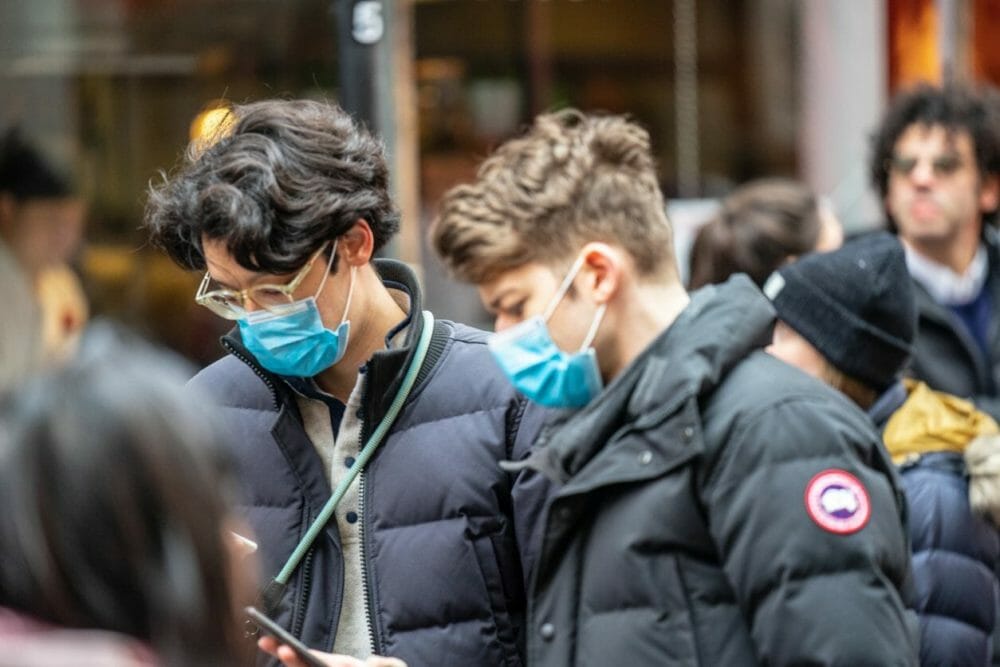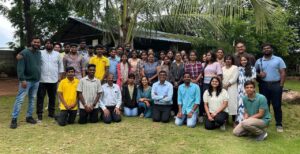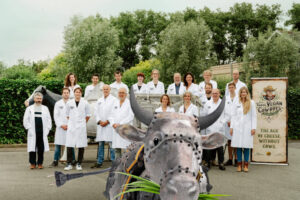Editors Note: Rob Leclerc is a founding partner of AgFunder, where he co-leads the investment team.
It’s hard to know how to respond to the spread of COVID-19. The virus is creating uncertainty across the world, impacting societies and businesses with varying degrees of severity.
I’ve seen a lot of bad advice in the media from people who don’t understand math, statistics, exponential systems, or tail risk: “Don’t worry,” they say. This is precisely the wrong advice because it encourages complacency at a time when we should be most vigilant. Tail risk is hard for people to get their heads around because most of the time we live in a linear world with linear outcomes. And so when we are faced with rare events with the potential for high magnitude outcomes, we find ourselves cognitively unprepared and apply old models of thinking. (For a quick primer on tail risk, I recommend Nasim Taleb’s The Fourth Quadrant: A Map of the Limits of Statistics.)
In 2012, I was in Manhattan for Hurricane Sandy. People were preparing all around me and, never having been in an event like that before, I wasn’t prepared. I lived in a brick building. How bad could it be? By the late afternoon, before the hurricane hit, the grocery store shelves were empty and there were hour-long lines. I thought, “maybe they know something I don’t,” so I bought some frozen meals and some bottles of water at a nearby convenience store thinking that I’d be covered. Boy was I wrong. Shortly after the hurricane hit, the power went out; electricity, running water, toilets were all unavailable. By the morning, we were out of water, my frozen food was thawed, I had no way of cooking anything, and my cellphone was dead. I didn’t even make it 12 hours.
Remembering that experience, last week I made a couple of trips to Costco to buy dried and canned goods, enough food and supplies for our family for a few weeks–it’s not just me anymore, I have a wife and two little ones. Some of the items that were sold out by the second trip included toilet paper, bottled water, hand sanitizer, hand soap, and vinegar. In Hong Kong, they seem to be getting a handle on the virus by practicing severe social distancing, but toilet paper is in short supply. You don’t want to find out what happens when you run out of toilet paper.
We are not at a stage of widespread panic buying yet, which means it’s a good time to prepare in an orderly fashion. While it’s highly unlikely that we’ll have a complete social and economic shutdown, you still do not want to be waiting in a crowded grocery line for several hours if the situation gets significantly worse. Preparing now will dampen the impact on the system later, and if this turns out to be a false positive, then the cost will have been low as you can still use what you bought.
With this in mind, I prepared a quick primer on the health and commercial risks our portfolio founders may face and how to think about responding to them, and I wanted to share it more broadly with the AgFunder community.
Risks
COVID19 carries two major risks: (1) the health of your friends, family, and coworkers; and (2) the potential for social and economic disruption. The greater the health risk becomes, the more likely we move to measures that lead to greater social and economic disruption. As I write this we are seeing cryptic transmission in the U.S., significant flare-ups in places like Italy, and Iran, and in China, Hong Kong it appears, at least for now, that they’ve been able to get some control over the spread of the virus. While the risks may blow over in a few weeks founders should be aware of the potential for worse outcomes and prepare accordingly.
Health Risks
Don’t compare COVID-19 to the seasonal flu or car accidents because these are in steady-state distributions. In 2021 from now, we’re not going to find that there were seven million road fatalities in the U.S. Similarly, the exponential growth of the seasonal flu is limited by large portions of the population getting vaccinated and developing resistance and there’s a well-defined distribution of outcomes. However, the introduction of a new form of the virus in 1918, the Spanish Flu, led to approximately 27% of the global population getting infected, and 40-50 million dying. This actually came over three waves, starting in January 1918 and ending in January 1920. Several of my great-great aunts and uncles died from the Spanish flu and at that time, people stayed in their homestead with no contact with others for almost a year.
Fortunately, the virus (SARS-CoV-2) that causes COVID-19 is not nearly as virulent as SARS or the 1918 Spanish Flu, and mortality rate estimates have ranged from 0.16% – 5%. The high mortality rate in Wuhan is likely from medical facilities being overwhelmed and a lack of resources. Of all fatalities, 80% are people 60 years and older with underlying conditions, and fortunately for most, the symptoms are mild. One passenger on the Diamond Princess who tested positive for COVID-19 said that his symptoms were mild and that, under normal circumstances, he would have gone back to work.
However, what makes COVID-19 particularly insidious is that the incubation period can take up to 14 days and it’s believed that people may be contagious before they start showing symptoms. Moreover, mild symptoms can easily be mistaken for the cold or flu. Therefore, the epidemic may be particularly difficult to stamp out. As of Feb 28th, the U.S. only had only done 459 tests, and it appears that some of these tests may have been flawed (False negative for at least one patient). Compare that to 65,000 tests in Korea. The good news is that there are purportedly now 75,000 kits that will soon be available in the U.S.
With six deaths in Washington attributed to community spread (no known travel history to high-risk regions or contact with infected people) it’s highly probable that COVID-19 has been spreading for as many as six weeks.
And here is the curve for COVID-19 epidemic with a doubling time of 7 days. As with the shorter doubling time, the epidemic can look like it is just smoldering for a long time (here, for over 2 months), until it (once again) explodes. | @R_H_Ebright @mqdicer pic.twitter.com/3O9yVNTM4B
— Nicholas A. Christakis (@NAChristakis) March 2, 2020
The good news is that like all other biological organisms, a virus will evolve to maximize its differential fitness, and so there is a tendency for viruses to become less virulent over time — killing or hobbling your host is not good business in the long run. Still, even a mortality rate of 0.1%, there’s the potential for 70 million deaths. Because of this ultimate risk, and the draconian measures governments and individuals would be willing to take to avoid the worst-case scenario, we could see significant social and economic disruption.
Your first priority is to take care of yourself and your family. You should think of preparation like buying life insurance. At this time, it’s not clear if you’ll need it, but the relative cost of preparation is still low, while the downside risk is high. This is the domain of black swans and you need to be thinking about covering your tail risk.
If you do find yourself sick at home, and the healthcare system is overwhelmed, you may want to ensure you have medication on hand like ibuprofen, anti-congestion, and electrolytes (dehydration). In the meantime, wash your hands frequently and make sure you’re getting eight hours of sleep so that you don’t compromise your immune system. If widespread infection does occur, we’ll want to slow the spread of the epidemic so that we don’t overwhelm our healthcare system.
Social and Economic Disruption Risk
While mortality rates for COVID19 are low, we are likely to face serious social and economic disruption if we don’t see fast containment. The problem, of course, is that the long incubation period may prematurely push us into a state of complacency. Founders should consider some of the risk and mitigating factors below:
Fundraising: In 2008-2009 during the World Financial Crisis, capital markets, as well as VC funding dried up. Sequoia sent out a now-famous internal presentation to its portfolio companies entitled “RIP Good Times” that was subsequently published in the press. It spooked a lot of angel investors, VCs and LPs. Over that period, many LPs backing VC funds asked their GPs not to issue capital calls and, in some cases, didn’t honor their capital commitments, making matters worse. As the WHO and CDC are now saying it’s a matter of when not if, it may just be a matter of time before fear takes hold of capital markets. If this happens we can expect that many investors will take a wait-and-see approach which will slow the overall funding pace. During SARS in Asia and Zika in South America, there was a significant drop off in private market funding, according to data from CB Insights. However, these two instances were regional, and the recovery was swift. When global markets seize, it can take time to jumpstart them again. You’ll want to reassess your spending and fundraising plans. If you’re closing a round now, don’t spend a lot of time optimizing, just get it done. Even the distraction and slower business cycles could stretch out timelines for investors who stay active. Still, good companies can always get funded but demand may put pressure on valuation and we intend to remain active investors.
Supply Chain: Manufacturing in China has come to a standstill. China’s Purchasing Managers Index (PMI) hit historic lows for February, even by the standards of the World Financial Crisis. We’ve spoken to a few of our portfolio companies and some are already seeing supply-chain problems. One company reported an increase in the price of hardware they were sourcing from China. While this should be temporary as the number of new cases is dropping in China, this could have ripple effects on availability or pricing. If there’s a second wave in China, it could be more problematic. If you have opportunities to diversify your supply chain, you’ll want to do it now.
Working from home: Our team is distributed across the US, Canada, Singapore, Australia, and Europe and we conduct a lot of our meetings over Zoom intermixed with daily Slack communication. It can be difficult, but it works for us. Please consider letting your employees work from home, which can reduce the incidences of both individual and team exposure. Culture is important, and it’s hard to build and maintain when you’re a remote team. We have a couple of watercooler Slack channels to talk about politics, events, making jokes, and to make sure we’re engaging with each other as human beings. Still, like us, you might find that without office distractions you’re more productive.
Stop shaking hands: It’s a long-standing ritual and it can be difficult to break. But just do it.
Sales: An extended period of social isolation and travel embargoes may make it challenging to close deals, particularly those that historically required a lot of face time. To speed up the sales process, and depending on your product, you may be able to FedEx samples to potential customers. (If it’s expensive and non-perishable, also send a return label). If you’re selling to large corporations, you’ll need to understand their risk exposure to COVID-19, as this could consume their attention. Deals with big corporations can kill a startup, especially when they’re distracted.
Distribution: Some of our foodtech portfolio companies were setting up for launches in foodservice and restaurants and we’ve told them that it may be a good time to speak to eGrocery and meal kits services.
Travel & Conferences: Major companies are canceling non-essential domestic and/or international travel, including Amazon, Facebook, and Google. A friend traveling to Expo West on Monday said that 60% of the attendees had canceled, only to find out upon arrival that the conference was subsequently postponed at the last minute. I had a keynote scheduled in Germany for April but felt that it was best to cancel ahead of time. International travel could be particularly risky as you could risk an unexpected closing of the border or quarantine that could keep you away from my family for an extended period of time. Just today, China ordered all travelers coming from South Korea, Japan, and Italy to be isolated for 14-day quarantine. Missing conferences can be tougher for startups as there is often a once-in-a-year conference you go to meet investors and customers. If your conference is canceled, maybe you can get creative and host a webinar and start publishing content to stimulate the ecosystem and stay in the conversation.
Passwords: This is a good time to review your password policy and make sure that you have redundancy in your system in case some of your team members are unavailable.
How can you learn more?
I’ve been following this site since late January and have found that it has accurate and up-to-date statistics on the spread of the coronavirus globally.
https://www.worldometers.info/coronavirus/
Thank you to my colleagues Yanniv Dorone and Louisa Burwood-Taylor for their suggestions. Any errors or omissions are mine.



